

China. China ( i/ˈtʃaɪnə/; Chinese: 中国; pinyin: Zhōngguó), officially the People's Republic of China (PRC), is a sovereign state located in East Asia.

It is the world's most populous country, with a population of over 1.35 billion. The PRC is a single-party state governed by the Communist Party, with its seat of government in the capital city of Beijing.[15] It exercises jurisdiction over 22 provinces, five autonomous regions, four direct-controlled municipalities (Beijing, Tianjin, Shanghai, and Chongqing), and two mostly self-governing special administrative regions (Hong Kong and Macau). The PRC also claims Taiwan – which is controlled by the Republic of China (ROC), a separate political entity – as its 23rd province, a claim which is controversial due to the complex political status of Taiwan.[16] Etymology History Prehistory Early dynastic rule. History of China. Chinese civilization originated in various regional centers along both the Yellow River and the Yangtze River valleys in the Neolithic era, but the Yellow River is said to be the cradle of Chinese civilization.

With thousands of years of continuous history, China is one of the world's oldest civilizations.[1] The written history of China can be found as early as the Shang Dynasty (c. 1700–1046 BC),[2] although ancient historical texts such as the Records of the Grand Historian (ca. 100 BC) and Bamboo Annals assert the existence of a Xia Dynasty before the Shang.[2][3] Much of Chinese culture, literature and philosophy further developed during the Zhou Dynasty (1045–256 BC). The Zhou Dynasty began to bow to external and internal pressures in the 8th century BC, and the kingdom eventually broke apart into smaller states, beginning in the Spring and Autumn Period and reaching full expression in the Warring States period.
Prehistory Paleolithic Neolithic Ancient China Capital: Yin, near Anyang. Tang Dynasty. History[edit] Establishment[edit] Administration and politics[edit] Initial reforms[edit] Taizong set out to solve internal problems within the government which had constantly plagued past dynasties.
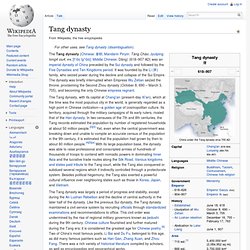
Building upon the Sui legal code, he issued a new legal code that subsequent Chinese dynasties would model theirs upon, as well as neighboring polities in Vietnam, Korea, and Japan. The Tang had three departments (Chinese: 省; pinyin: shěng), which were obliged to draft, review, and implement policies respectively. Tang era gilt-gold bowl with lotus and animal motifs Although the central and local governments kept an enormous number of records about land property in order to assess taxes, it became common practice in the Tang for literate and affluent people to create their own private documents and signed contracts. Qing Dynasty. The dynasty was founded by the Jurchen Aisin Gioro clan in Northeastern China, historically known as Manchuria.
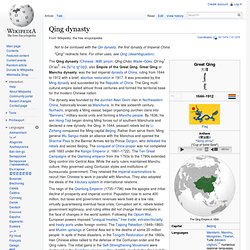
In the late sixteenth century, Nurhachi, originally a Ming vassal, began organizing Jurchen clans into "Banners," military-social units and forming a Manchu people. By 1636, his son Hong Taiji began driving Ming forces out of southern Manchuria and declared a new dynasty, the Qing. In 1644, peasant rebels led by Li Zicheng conquered the Ming capital Beijing. Yuan Dynasty. The Yuan dynasty (Chinese: 元朝, Modern Yuán Cháo; Mongolian: Dai Ön Yeke Mongghul Ulus, Их Юань улс, Ikh Yuanʹ Üls[1]) also Mongol dynasty, was the empire established by Kublai Khan, leader of the Mongolian Borjigin clan, after he conquered the Southern Song dynasty in China.
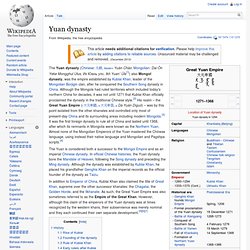
Although the Mongols had ruled territories which included today's northern China for decades, it was not until 1271 that Kublai Khan officially proclaimed the dynasty in the traditional Chinese style. Zhou Dynasty. During the Zhou dynasty, the use of iron was introduced to China,[1] though this period of Chinese history produced what many consider the zenith of Chinese bronze-ware making.
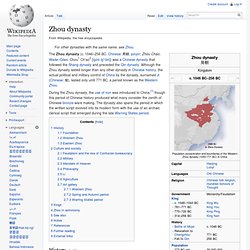
The dynasty also spans the period in which the written script evolved into its modern form with the use of an archaic clerical script that emerged during the late Warring States period. History[edit] Foundation[edit] Western Zhou[edit] Ming Dynasty. Chinese Civil War. The war represented an ideological split (Left vs.

Right) between the Communist CPC, and the KMT's brand of Nationalism. The civil war continued intermittently until late 1937, when the two parties formed a Second United Front to counter a Japanese invasion. China's full-scale civil war resumed in 1946, a year after the end of hostilities with Japan. After four more years, 1950 saw the cessation of major military hostilities—with the newly founded People's Republic of China controlling mainland China (including Hainan), and the Republic of China's jurisdiction being restricted to Taiwan, Penghu, Quemoy, Matsu and several outlying islands. Historian Odd Arne Westad says the Communists won the Civil War because they made fewer military mistakes than Chiang Kai-shek, and because in his search for a powerful centralized government, Chiang antagonized too many interest groups in China.
Background[edit] Northern Expedition and KMT-CPC split[edit] NRA soldiers marching. Communist Party of China. While the CPC is still committed to communist thought, mainstream foreign opinion believes the party to be non-ideological.
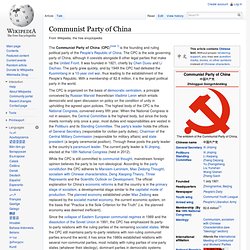
According to the party constitution the CPC adheres to Marxism–Leninism, Mao Zedong Thought, socialism with Chinese characteristics, Deng Xiaoping Theory, Three Represents and the Scientific Outlook on Development. Quotations from Chairman Mao. 1964 book of statements by Mao Zedong Quotations from Chairman Mao Tse-tung (simplified Chinese: 毛主席语录; traditional Chinese: 毛主席語錄; pinyin: Máo Zhǔxí Yǔlù) is a book of statements from speeches and writings by Mao Zedong (formerly romanized as Mao Tse-tung), the former Chairman of the Chinese Communist Party, published from 1964 to about 1976 and widely distributed during the Cultural Revolution.
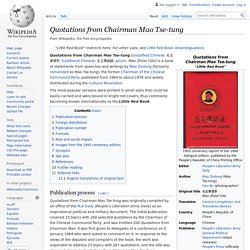
The most popular versions were printed in small sizes that could be easily carried and were bound in bright red covers, thus commonly becoming known internationally as the Little Red Book. Publication process[edit] Quotations from Chairman Mao Tse-tung was originally compiled by an office of the PLA Daily (People's Liberation Army Daily) as an inspirational political and military document. Zhou Enlai. Zhou Enlai (pinyin: Zhōu Ēnlái; Wade-Giles: Chou En-lai; IPA: [tʂóʊ ə́nlǎɪ]; 5 March 1898 – 8 January 1976) was the first Premier of the People's Republic of China, serving from October 1949 until his death in January 1976.
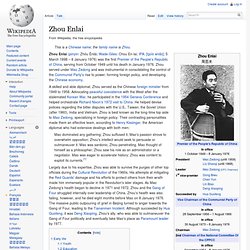
Zhou served under Mao Zedong and was instrumental in consolidating the control of the Communist Party's rise to power, forming foreign policy, and developing the Chinese economy. Mao dominated any gathering; Zhou suffused it. Mao's passion strove to overwhelm opposition; Zhou's intellect would seek to persuade or outmaneuver it. Mao was sardonic; Zhou penetrating. Mao thought of himself as a philosopher; Zhou saw his role as an administrator or a negotiator.
Early life[edit] Deng Xiaoping. Deng Xiaoping (Pinyin: Dèng Xiǎopíng, [tɤŋ˥˩ ɕjɑʊ˩ pʰiŋ˧˥] ( ); 22 August 1904 – 19 February 1997) was a politician and reformist leader of the People's Republic of China who, after Mao's death led his country towards a market economy. Jiang Zemin. Hu Jintao. During his term in office, Hu reintroduced state control in some sectors of the economy that were relaxed by the previous administration, and has been conservative with political reforms.[1] Along with his colleague, Premier Wen Jiabao, Hu presided over nearly a decade of consistent economic growth and development that cemented China as a major world power.
He sought to improve socio-economic equality domestically through the Scientific Development Concept, which aimed to build a "Harmonious Socialist Society" that was prosperous and free of social conflict.[2] Meanwhile, Hu kept a tight lid on China politically, cracking down on social disturbances, ethnic minority protests, and dissident figures. In foreign policy, Hu advocated for "China's peaceful development", pursuing soft power in international relations and a business-oriented approach to diplomacy.